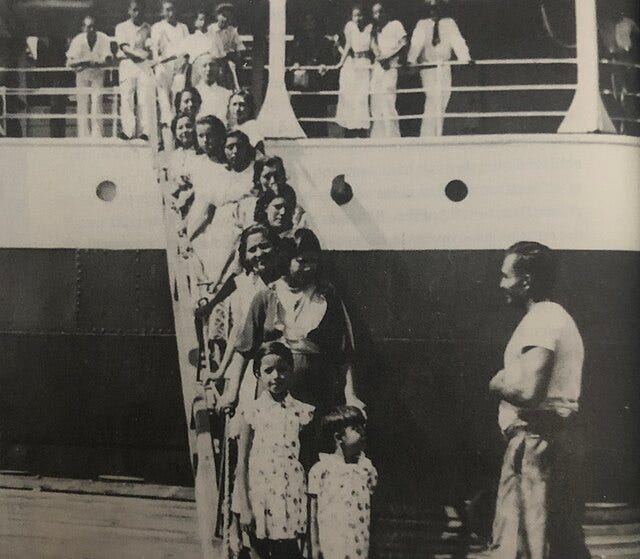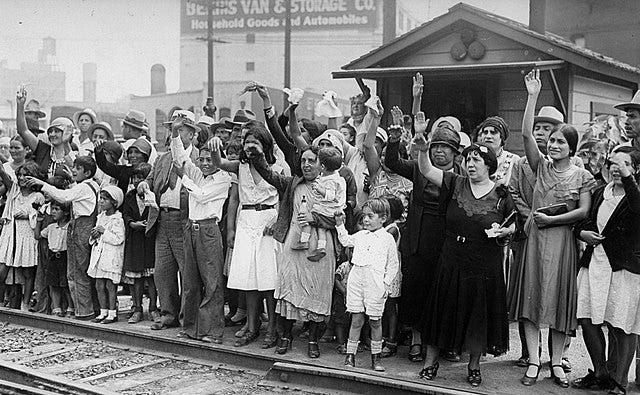Another quick side note on the First Bracero Program of 1917
I swear I'm going to get back to the Great Oahu Sugar Strike of 1920 and tie it all together.

I’m currently finishing up drafting a law review article and hoping to get it into cycle before all the law students go into exams. So I still don’t have time to get to Part 2 of the Great Oahu Sugar Strike again this week (finishing up Part 1):
But I swear this is all going to tie together along with that seemingly random story about Yung Wing, the guy who went all in “Boola Boola” culture in the 1850s.
Also, I’m really not looking to do a current events blog. I’m just saying, I was zero days old when I learned that, in the early 1930s, there was something called “repatriation” that involved quite a number of Mexican residents and Mexican-American U.S. citizens who were “repatriated” en masse to Mexico.
How did they come into the United States to begin with? That’s where the First Bracero Program comes into play.
The 1917 Immigration Act is also known as the Asiatic Barred Zone Act, for its exclusion of immigrants from an entire zone of Asia that encompassed not only China, but also most British and Dutch Asian colonial possessions as far west as Arabia and Afghanistan, the Soviet Union east of the Ural Mountains, and most of Polynesia. However, with Europeans also largely precluded by wartime conditions from immigrating to the United States and a million working-age American men being sent to Europe to fight alongside them, suddenly the United States had a huge need for unskilled laborers to work on the railroads and in the agricultural sectors. Where did we turn for this new source of unskilled “coolie” labor? Mexico, of course.
It was a match made in heaven. Unskilled Mexican laborers seemed more than amenable to coming into the United States at that time, given the considerable amount of Pancho-Villa-related unrest going on in Mexico at that time.
Accordingly, the United States and Mexico implemented what is now known as the First Bracero Program (the word “bracero” meaning roughly “one who works with his arms”). The program would later be revivified during World War II.

Rule 13 of the 1917 implementing rules issued by the Labor Department’s Bureau of Immigration, governing inspection on the Mexican border, specifically contemplated the admission of aliens “who enter the United States with the avowed intention of remaining for a temporary period only and who, on the basis of such claim, are not required to undergo the detailed inspection enforced in the cases of aliens who declare an intention of remaining permanently.” I guess this was all supposed to work based on…the honor system?
Well, turns out a number of Mexican Braceros, some of whom may well have been genuine in “their avowed intention of remaining for a temporary period only,” had nonetheless developed quite different intentions upon comparing general living conditions in the United States to those in Mexico. Some of them eventually gave birth to children who now had birthright citizenship pursuant to the Fourteenth Amendment, thanks to one of their Chinese-American counterparts named Wong Kim Ark who had gotten the matter settled for them in the U.S. Supreme Court in 1898.
However, none of this seemed to matter in the early 1930s, when the U.S. Government, in an entirely predictable reaction to the Great Depression and the sight of unemployed American white workers lining up in front of soup kitchens, decided that the First Bracero Program had gone entirely too far and embarked upon a new program of what it deemed “repatriation.” According to Kevin R. Johnson, Associate Dean of the law school at UC-Davis, who gave a lecture on the topic in 2005,
[t]he forced "repatriation" of an estimated one million persons of Mexican ancestry from the United States included the removal of hundreds of thousands of people from California, Michigan, Colorado, Texas, Illinois, Ohio, and New York during the Great Depression. It is clear today that the conduct of federal, state, and local officials in the campaign violated the legal rights of the persons repatriated, as well as persons of Mexican ancestry stopped, interrogated, and detained but not removed from the country. The repatriation campaign also terrorized and traumatized the greater Mexican-American community.
He adds,
Approximately 60 percent of the persons of Mexican ancestry removed to Mexico in the 1930s were U.S. citizens, many of them children who were effectively deported to Mexico when their immigrant parents were sent there. My colleague, Professor Cruz Reynoso, former Associate Justice of the California Supreme Court, was one of the so-called repatriates. A U.S. citizen by birth, a young Cruz could only ask his father "where is Mexico?" when informed that the Reynoso family was moving from southern California to south of the U.S./Mexico border.


The fact that I didn’t know about the “repatriation” program of the 1930s until a few days ago is probably a function of the fact that there’s no U.S. Supreme Court case called Reynoso v. United States. But why isn’t there? For that matter, why did so many seminal immigration/constitutional cases of the late 19th century/early 20th century involve parties with names like Wong Kim Ark, Chy Lung, Yick Wo, and Chae Chan Ping? There was eventually an immigration case before the Supreme Court involving a Mexican national, called Galvan v. Press, but that wasn’t until 1950, and it didn’t turn out so well for the Mexican.
So, why were the Chinese immigrants so much more successful than the Mexican immigrants (and U.S. citizens of Mexican ancestry!) when it came to asserting their constitutional rights? The difference boils down to just this: lawyers.
Wong Kim Ark, it turns out, was part of a Chinese immigrant community in San Francisco that had some mutual aid societies and consistently good access to sharp Constitutional lawyers. For all the white Californians’ complaints that the Chinese immigrants were not and could not assimilate to the uniquely Anglo-Saxon system of American government, the Chinese were in fact some of the most enthusiastic of all immigrant communities for the uniquely American tradition of bringing lawsuits at the drop of a hat.
The Chinese also had the benefit of coming from a civilization that had a 2,000-year head start on the United States in its management of a sophisticated administrative state staffed with highly qualified career bureaucrats. Confucianism had its strong points. The Mexicans did not come from such a tradition, and apparently the Braceros and their progeny either couldn’t afford lawyers and/or had no one offering to represent them pro bono. It’s interesting to me that the Chinese were also migrating to Mexico around the same time they were migrating to California, and that, after the U.S. enacted the Chinese Exclusion Act of 1882, those Chinese immigrants, who had brought the opium trade with them—the opium that had been smuggled into China from India by the British against the Chinese Emperor’s wishes—apparently got really good at smuggling people across the U.S.-Mexican border in addition to all the opium. That’s a topic for a different day.
But there’s a larger point to be made here. Let’s get back to agriculture. I would posit that homo sapiens has a problem of Jared-Diamond-Guns-Germs-and-Steel-Level magnitude (remember this guy?)
…which is this: Somehow, quite a number of us have gotten it into our heads that some other select group of our species are going to come over onto our fields, pick our crops for us at little to no cost, maybe even work in our slaughterhouses for us (boy, is that some nasty business), acquire zero legal rights, and go back where they came from when they’re done. And that this is going to be a sustainable arrangement over the long term. How many times do we need to re-learn the lesson that it’s not? Apparently, nobody likes picking the crops. If given the opportunity to do anything for a living other than pick the crops all day long, we will all opt, at the first opportunity, to do the thing that is not picking the crops. But if each and every one of us thinks that it’s definitely someone else who should go out and pick the crops, um, how is this supposed to work? Also, we all really like cheap groceries.
What’s the long-term fix here that breaks the cycle? Do we all need backyard gardens? Do we need androids? Would even that break the cycle, or would we all just end up in basically Blade Runner?
This was a phenomenally underrated sequel, by the way.
I swear it’s all going to make sense when I finally get to Part 2 of the Great Oahu Sugar Strike of 1920. In the meantime, who do you think has a better handle on what human civilization requires—Jared Diamond or this Jared Leto character in the above trailer? (At the risk of tipping the balance one way or the other, I should mention that I’m pretty sure the Jared Leto character is considered that movie’s villain).







